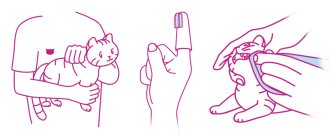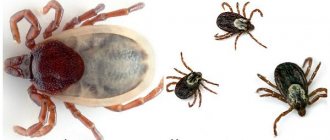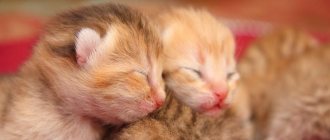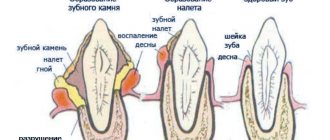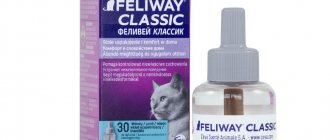What will you learn from the article?
- Does a cat need to brush its teeth?
- Why brush your cat's teeth?
- How to brush your cat's teeth How often should you brush?
- What you need for cleaning
- How to properly brush your cat's teeth at home
- At what age should cats be taught to brush their teeth?
- Alternative cleaning method
- Best Cleaning Products
Brushing your cat's teeth is the most effective way to reduce plaque, prevent tartar, and maintain long-term oral health. This procedure prevents many dental diseases and keeps the cat's breath fresh.
How to teach a kitten to brush its teeth? How correctly and how often should this be done? What means and tools should I use? You will find answers to all these questions in our article.
Do cats need to brush their teeth?
Is it possible to brush a cat's teeth? Need to! More than half of cats over 3 years old suffer from periodontal disease - inflammation of the tissues to which crowns are attached. It begins as gingivitis (inflammation of the gums) due to plaque accumulated on the teeth, where colonies of bacteria live. If plaque is not removed, tartar forms, creating a good environment for the development of microbes. In addition, the stone comes into contact with the gum, irritating it, causing inflammation. If the disease is neglected, the pet may lose teeth.
Other problems that may arise in cats if you decide that cats do not need to brush their teeth:
- caries;
- bleeding gums;
- bad breath;
- poor appetite;
- depressed mood;
- diseases of the digestive system due to putrefactive bacteria that came here from the oral cavity.
Of course, one could argue that wild cats have good teeth and don't need any cleaning. But their situation is different. They hunt and chew hard food, which allows them to clean the enamel of deposits. In addition, tough pieces of meat are less likely to get stuck in the teeth, while soft food, which is what indoor cats mostly eat, easily gets deposited between the crowns.
Toothpaste
The solution to the problem of oral and dental hygiene is quite simple - timely care and the use of toothpaste, which can not only gently clean the teeth of your beloved pet, but also eliminate the causes of caries, protect the gums from irritation, and help get rid of unpleasant odors.
This is achieved by destroying microorganisms that accumulate in the mouth and mechanically cleaning the oral cavity of any food debris.
IMPORTANT! Toothpaste for a cat is not the same toothpaste that we use to brush our teeth in the morning; it is very different in its chemical composition. In addition, most types of toothpastes used by humans containing fluoride are very toxic for animals.
Composition and other features
Toothpastes have now been developed that taste like meat, liver, and even fish. This greatly simplifies the cleaning procedure, since any cat likes such flavor solutions. There are mint flavored pastes that have a refreshing effect.
Sometimes you can't brush your pet's teeth with standard toothpaste. Then you need to use a liquid toothpaste for animals that has neither taste nor odor, which is the easiest to use and, when added to a drinking bowl, has the same effect as a standard toothpaste for cats.
In addition, there is a range of other products: special pads, tooth powder, rinses, which are also used to strengthen and cleanse teeth.
Cat paste may contain bone meal. In addition, they contain glycerin, triphosphate, carageenan and some important enzymes. Each paste designed for cleaning and getting rid of tartar has its own unique specific composition . Among the brands producing cat toothpaste, the most famous are Beaphar, Trixie, and Cliny.
How to brush your cat's teeth at home
To clean your cat's mouth, use a pet toothbrush. On sale are:
- a toothbrush with curved handles to make it easier to handle the mouth;
- brushes that fit comfortably in your hand;
- fingertips – brushes that fit onto the finger.
If you don’t have one, a child’s, very soft toothbrush will do. If you are unsure whether the appliance can be used, make sure the bristles fall just below the gum line. As a last resort, you can use gauze wrapped around your finger or a cotton swab.
How to clean a cat's teeth?
In veterinary stores and pet pharmacies you can buy toothpaste for cleaning cats' teeth. They contain substances that are harmless to her and a smell that she will like.
Can toothpaste be used on humans?
Human pastes cannot be taken. They contain substances that should not be swallowed, and while a person can resist the reflex movement, a cat cannot. Swallowing the paste may cause digestive upset.
Can you use baking soda for cleaning?
No. Baking soda contains a lot of alkaline, which if swallowed can upset the acid balance in the stomachs. In addition, the pet may not like the taste of the product, and it will vomit during the procedure.
Caring for your cat's mouth
Just like ours, cats' mouths need care. Poor dental health can lead to a number of unpleasant diseases and even cause tooth loss.
A cat's mouth is not the cleanest place at the best of times. A lot of bacteria will enter your cat's mouth every day from food, grooming, and anything else they receive during the day. To keep your cat as healthy as possible, you will need to help her a little with her hygiene.
There are many things you can do to help improve your cat's dental health.
Brushing
It may seem like an impossible task, but brushing your cat's teeth can really help them. This is easier if they get used to it as kittens, but older cats can learn to let you do it too. You will need:
- Cat toothpaste. Never use human toothpastes on your pets as they may not spit it out.
- A cat toothbrush, finger brush, or microfiber cloth is intended for cleaning teeth.
You will need to gradually get your cat used to brushing their teeth. Follow these simple steps and remember that you can only move on when your cat is completely satisfied with your step:
- Give them some toothpaste on their finger at about the same time every day. This will allow them to get used to the taste and smell. If they don't take it off your finger first, you can offer it to them on their food bowl or put a small amount on their front paw for them to lick it off and work towards feeding it off your finger.
- Gently touch the corners of the cat's mouth, avoiding touching the whiskers (vibrissae). Work on lifting their lips so you can see their teeth.
- Begin to gently touch the outer surfaces of your teeth and gums to get them used to being touched around and inside your mouth.
- Once they are happy with this, you can begin to inject some toothpaste onto your finger.
- Then use the toothbrush, making small circular motions along the outer surface of the teeth. Always brush gently and do not brush directly on their gums.
Remember that if your cat already has problems with the mouth or teeth, they may be quite sore and tender around the area. If they show signs of pain or their gums look sore or are bleeding during any of these steps, then stop the process and talk to your veterinarian for further advice.
Dental gel
If your cat really won't tolerate you brushing its teeth, you can try dental gels. You won't need a brush with the gels, but you will need to apply them to your cat's teeth. Try to get them used to having their mouth and teeth touched in the same way as brushing. Once you both feel comfortable, this should become a daily practice.
Gels do not remove plaque from your cat's teeth, so they are not as effective as brushing. They can help slow down the development of problems.
Mouth rinses
Like dental gels, mouthwashes that you put in your cat's water can help slow plaque buildup, but won't prevent or reduce it the way brushing teeth does.
Diet
Feeding your cat the right diet can really help keep her mouth healthy. Feed your cat a complete diet that is appropriate for her current life stage.
It is up to you whether you give your cat wet food, dry food, or formula. Dry biscuits can help improve dental health, but wet foods will keep them hydrated, which can be important if they are prone to certain diseases. Feeding them both means they get the benefits that both types of food have. If you need any specific guidance, you can read what to feed your cat.
If your cat is prone to dental problems, your veterinarian may recommend a specially formulated food designed to stop plaque buildup.
Dental treatment
You can buy treats for your cat that are designed to keep their teeth clean. They are good as a preventative, but you should not rely on them for your cat's dental health. Try not to feed your cat too many treats to keep their weight at a healthy level.
Regular checkups
The best way to make sure you're keeping your cat's mouth healthy is through regular checkups with your veterinarian. It's best to check your cat's mouth every 6 to 12 months. Signs that your cat may have dental problems include:
- sore red gums
- gums that always bleed
- bad breath
- the cat refuses to eat (their teeth may be too painful to eat)
- take less care of themselves, or do not take care of themselves at all
- excessive drooling
- swelling around the jaw or cheeks
- pus or blood coming from the mouth or nose
- loose tooth
If you begin to notice these signs, contact your veterinarian. They will be able to thoroughly check your cat.
If your cat has dental problems
Dental problems are quite common in cats. As soon as you begin to notice any symptoms of potential problems, contact your veterinarian for advice.
Taking care of your cat's mouth can help prevent a variety of dental problems. But if your cat does have oral problems, there are steps you can take to make their life easier:
How to properly brush your cat's teeth
The manipulation should be carried out according to the following scheme:
- Apply a dental gel to your brush to clean your cat's teeth.
- Position your pet's head at a 45-degree angle and gently lift its lips. You don't have to open the cat's mouth.
- Concentrate first on cleaning the large back teeth and canines, where plaque builds up most often.
- Proceed slowly and carefully. If the bristles touch your gums, it can cause irritation.
- Don't worry if your pet won't open his mouth or let you brush the tips and inside of his teeth. Most damage affects the outer part of the crowns, the periodontium. In addition, a cat's tongue is better than a human's at removing tongue from the inside of crowns, reducing the need for cleaning them.
- Gradually clean all crowns.
- The average cleaning time is 30-60 seconds. from each side.
Take your time during the procedure. Your pet's teeth should be brushed slowly and carefully so as not to scare the animal. Be sure to praise him.
How to brush a cat's teeth with a fingertip
If you don’t have a brush, you can clean the cat’s mouth with a fingertip using the same method. Before starting the procedure, train the cat to place the owner's finger in the pet's mouth. To do this, you can do a gentle massage of the gums, smearing your finger with food tasty for the cat, allowing it to be sniffed and licked.
How to prepare your cat for the procedure
Accustoming to the procedure of brushing teeth should be gradual, regardless of the age of the cat. You shouldn’t try to get into your pet’s mouth and put things in order the first time - a small predator is unlikely to like this, and such aggressive actions will form in him a negative attitude towards cleaning, which will significantly complicate further training. You need to act step by step and carefully:
- Invite your cat to get acquainted with new objects - let him sniff a brush or a tube of cleaning product. You can dispense a small amount of paste and let it taste.
- Start getting your pet used to having their teeth touched. To begin with, simply placing your fingers on your teeth will be enough. Be sure to reward your animal with a treat every time for being patient.
- Gradually increase the time your finger remains on your teeth. When the cat sits calmly in this position, you can begin to make circular movements with your finger.
- Once you have achieved a calm reaction from your cat to your finger, you can try replacing it with a brush. Applying the paste to the bristles will make your pet more interested in the process. To prevent the cat from immediately licking off all the product, when squeezing it out, push it deeper to the base of the bristles.
It is important to carry out all manipulations in a calm environment, finding the cat in a good mood and well-being. If the animal refuses to participate, there is no need to force it, it is better to try again later.
How to teach a kitten to brush its teeth
It is easiest to accustom a small kitten to the procedure. If the cat is an adult, the process may take longer. At first it will not be easy, but then the pet will get used to cleaning and will not pay attention to it.
To teach your kitten to brush, do this:
- Find a quiet, peaceful place where you can place your kitten. It is better to start training when the pet is on your lap, but you can put it on the table after laying down a towel. Make sure the door can be closed to block any escape route.
- Dip a cotton swab into the tuna liquid. Cats love the taste and it provides a good association with brushing their teeth.
- Raise the kitten's lips; you don't have to open your teeth.
- Rub the cotton swab onto your lips and the edges of your gums.
- The first few times, it is better to use a cotton swab to wipe a couple of crowns, not all of them, especially if the kitten is unsure and nervous.
- When your pet gets used to the procedure, you can start using the brush.
Oral diseases in cats
Cats can experience a variety of dental and oral problems, especially as they age. Here are some of the most common problems to look out for:
- Broken teeth. Cats of all ages can break a tooth for a variety of environmental and health reasons. Your veterinarian will decide whether to remove the broken tooth depending on where in your mouth it is located. As part of a complete dental exam, your cat will have an x-ray taken under sedation to examine the broken tooth and make sure the root is not affected or that there is no wider oral disease lurking under the gum line.
- Gingivitis. This is an inflammation of the gums, caused, among other things, by the formation of plaque. If left untreated, gingivitis can develop into periodontal disease, which affects the gums and bone that hold your pet's teeth in place.
- Tooth resorption. The cause of this disease is still unclear, despite the fact that it affects nearly three-quarters of all cats five years of age or older, according to the Cornell University Feline Health Center. During resorption, the inner material of the tooth, dentin, is destroyed, causing the tooth to break and cause painful chewing.
- Periodontitis. In this gum disease, which is common in older cats, the ligaments and tissue surrounding the teeth recede and expose the root. Affected teeth usually need to be removed.
- Stomatitis. As with gingivitis, bacteria can spread throughout the mouth and affect the tissues of your pet's cheeks and throat. Veterinary Practice News warns that this condition can be quite painful for your four-legged friend. Stomatitis tends to be more common in animals with FIV (feline immunodeficiency virus), but you should contact your veterinarian immediately if your cat's mouth is red and swollen, or if she moans when she tries to eat.
If you notice any of these problems or suspect that your cat may have dental problems, take her to your veterinarian as soon as possible. Dental problems are very painful and serious for her - as well as for you. Brushing your teeth at home and regular checkups with your veterinarian will help your furry beauty maintain a healthy mouth for the rest of her life.
Professional teeth cleaning for cats
Veterinarians recommend bringing your pet to the clinic once a year to evaluate the condition of the oral cavity. If the doctor detects inflammation or other problems with the gums, he will prescribe a medicine that will stop the disease in time.
Stones: what to do?
A timely examination by a veterinarian will help to detect and remove stones in time. If it forms, immediately go to the dentist. Remedies that offer to remove stones at home are ineffective. They can only prevent its occurrence, while solid formations must be removed by a specialist.
Cleaning stones on the teeth of cats can be done both with and without anesthesia. The second option is possible only if the pet behaves calmly and obediently opens its mouth.
In most cases, ultrasonic cleaning of cats' teeth is used. The procedure is expensive, but does not damage the enamel. Ultrasonic cleaning of a cat's teeth is carried out under anesthesia, since the cat may be frightened by the buzzing device or splashing water.
Before anesthesia, the doctor must carefully examine the pet and take tests to determine how it will tolerate the injection. This is especially important for kittens and older pets. The wrong dose can kill.
Caries: what to do?
Caries must be treated. Even if it doesn’t cause problems for your pet at first, sooner or later rotting will affect the roots, and then trouble will begin. Treatment of caries provides 2 options - crown removal and filling. The first is widespread, the second is possible only in advanced clinics and is expensive.
Where to start
First you need to introduce your pet to a toothbrush and toothpaste. As an option, let the cat try the paste little by little, which will ensure that the pet gets used to it, then when further brushing his teeth he will not be too frightened. To do this, give him the opportunity to calmly sniff them and examine them.
You need to do this every day at the same time, take the cat in your arms and let it lick the paste applied to them from your fingers, and then try to do the same with a toothbrush. When cleaning for the first time, the brush is not used . You can use a cotton swab, and after a short time begin to teach your cat to brush his teeth.
ATTENTION! It is better not to use your finger wrapped in fabric material as a brush. The reason is clear: even a very tame pet under stress can cause serious damage to its owner. Gradually move on to using a brush.
The easiest way is to teach your cat to brush from an early age. Therefore, attention should be paid to brushing your kitten’s teeth from an early age. But if a pet has not been accustomed to brushing since childhood, this never means that brushing the cat’s teeth is no longer necessary. It's never too late to start.
The right time
Teeth cleaning is carried out when the animal does not have any health problems . To carry out the procedure, you need to choose a quiet time when the pet is full, absolutely nothing bothers him, and he is not going to sleep. During such a period of time, the animal shows maximum curiosity, this can only play into the hands of its owner.
How to maintain oral hygiene other than brushing?
There are special dry foods on sale for cleaning cats' teeth. They contain substances that prevent the appearance of stones. They also have a structure that allows mechanical cleaning of crowns.
You can buy treats for cats to clean their teeth, which your pets will happily chew on. Cat dental cleaning pads have a hard surface that cleans the canines. Their active components destroy plaque and kill bacteria.
For teeth, there are commercially available oral fluids. They have cleansing effects and eliminate unpleasant odors. You just need to add them to your drink. Manufacturers assure that the drug for cleaning teeth in cats is safe and does not affect the functioning of the digestive tract. As for users, opinions vary. Some helped, others had no effect, and others experienced vomiting and diarrhea.
Myth
For some cat owners, brushing teeth is not a mandatory hygienic procedure that needs to be performed when grooming . Their argument: cats can easily do without it; after all, domestic animals are descendants of wild ones, and teeth cleaning is not provided in the wild.
But it's not that simple. This is a misconception. Even in the wild, animals' teeth are cleaned of food debris. The diet of most of our pets consists of artificial food, which has great differences in its mechanical characteristics from the food that wild animals obtain for themselves.
ATTENTION! It is with food that dental problems in domestic cats are associated: the formation of tartar, inflammation of the gums, and the appearance of other diseases affecting the oral cavity.
Unlike coarse natural food containing tendons, bones, skin, dry or canned animal food, which most pet lovers now use, completely excludes self-cleaning of teeth.
Tips for cleaning your cat's mouth
- There are a lot of bacteria in a cat's mouth, so wear gloves during the procedure. If you cannot manipulate them, wash your hands thoroughly after finishing work.
- After the procedure, wash your toothbrush thoroughly.
- Change your cat's toothbrush every three months.
- If you have several pets, buy a separate cat hygiene product for each pet.
- Provide your cat with quality food. It has a good effect on the condition of teeth, making them resistant to decay.
- Before brushing, let your pet smell a sample of the paste. If he likes the smell, he will be more accommodating.
- Be sure to praise the cat during the procedure.
- If you can’t regularly remove plaque, buy treats - pads, teeth cleaning sticks for cats - by looking through the pet supplies catalog.
How to make a choice
Before starting to use a specific type or brand of toothpaste, it is best to consult with specialists. Some toothpastes have contraindications. A specialist will tell you which products are best suited for your beloved pet.
The choice of brush should also not be approached rashly. Human toothbrushes will not work. They are characterized by very long bristles and can injure the animal's gums. There are two types of special toothbrushes for cats: massage and bristly. It is advisable to use them alternately .
If cleaning is necessary for several cats at once, then the number of toothbrushes should correspond to their number. Toothpaste and brushes should be purchased only in specialized stores, or better yet, in a veterinary pharmacy.
